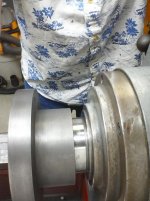eaglehatman
Plastic
- Joined
- May 3, 2020
I recently acquired a Porter McLeod 16" Model L lathe. The past month has been spent taking it apart, cleaning, lubing, replacing missing fasteners, generally taking care of upkeep and maintenance that had been neglected for decades. My goal is to use it for puttering around with jobs too big to fit on my 9" South Bend Model C.
The spindle is threaded at the EVER-POPULAR 2-3/16 - 7tpi. Of the (2) backplates that I have cleaned up (I got 3 chucks with it… still waiting for the guy to bring me the face-plate, and the third chuck weighs over 100 pounds - so I haven't really dug into it), one is the correct size (the one that came mounted to the spindle that I struggled for 2 weeks to remove). The second one is the slightly more common 2-1/4 - 8tpi. It jams up onto the spindle threads after (3) turns, about 1/2 inch from the shoulder. Total number of threads available on the spindle is 6... so really, half engagement is not terrible, but jam-up before contacting the shoulder does not provide good alignment or structural support of the chuck, and would probably make removal problematic if I try to use as-is. I cannot buy the correct back-plate because it does not exist (that I have found), and I have never tried to single-point machine an internal thread (lacking both tooling and experience). The mis-matched back-plate really has two other out-of-spec conditions... the plain-section of the bore is too short and also too large in diameter. My thought is that the most reasonable first-pass compromise to make it useable is to simply plain-bore a section of threading to the proper diameter, as deep as necessary to allow contact with the shoulder. If I were tooled up in a real machine shop with some professional machinist skillz, I might also try to line up and re-cut the threads to the proper pitch - at least deep enough to get the full 6-thread engagement instead of three. But really, without some way to measure or go/no-go the threads, it would be difficult to know if I even got that right. I think I need to duplicate the spindle geometry on a piece of round-stock that I can then use for assessing any future back-plate that I may try to machine. That's one step toward a long-term solution...
Any thoughts or advice?



The spindle is threaded at the EVER-POPULAR 2-3/16 - 7tpi. Of the (2) backplates that I have cleaned up (I got 3 chucks with it… still waiting for the guy to bring me the face-plate, and the third chuck weighs over 100 pounds - so I haven't really dug into it), one is the correct size (the one that came mounted to the spindle that I struggled for 2 weeks to remove). The second one is the slightly more common 2-1/4 - 8tpi. It jams up onto the spindle threads after (3) turns, about 1/2 inch from the shoulder. Total number of threads available on the spindle is 6... so really, half engagement is not terrible, but jam-up before contacting the shoulder does not provide good alignment or structural support of the chuck, and would probably make removal problematic if I try to use as-is. I cannot buy the correct back-plate because it does not exist (that I have found), and I have never tried to single-point machine an internal thread (lacking both tooling and experience). The mis-matched back-plate really has two other out-of-spec conditions... the plain-section of the bore is too short and also too large in diameter. My thought is that the most reasonable first-pass compromise to make it useable is to simply plain-bore a section of threading to the proper diameter, as deep as necessary to allow contact with the shoulder. If I were tooled up in a real machine shop with some professional machinist skillz, I might also try to line up and re-cut the threads to the proper pitch - at least deep enough to get the full 6-thread engagement instead of three. But really, without some way to measure or go/no-go the threads, it would be difficult to know if I even got that right. I think I need to duplicate the spindle geometry on a piece of round-stock that I can then use for assessing any future back-plate that I may try to machine. That's one step toward a long-term solution...
Any thoughts or advice?







